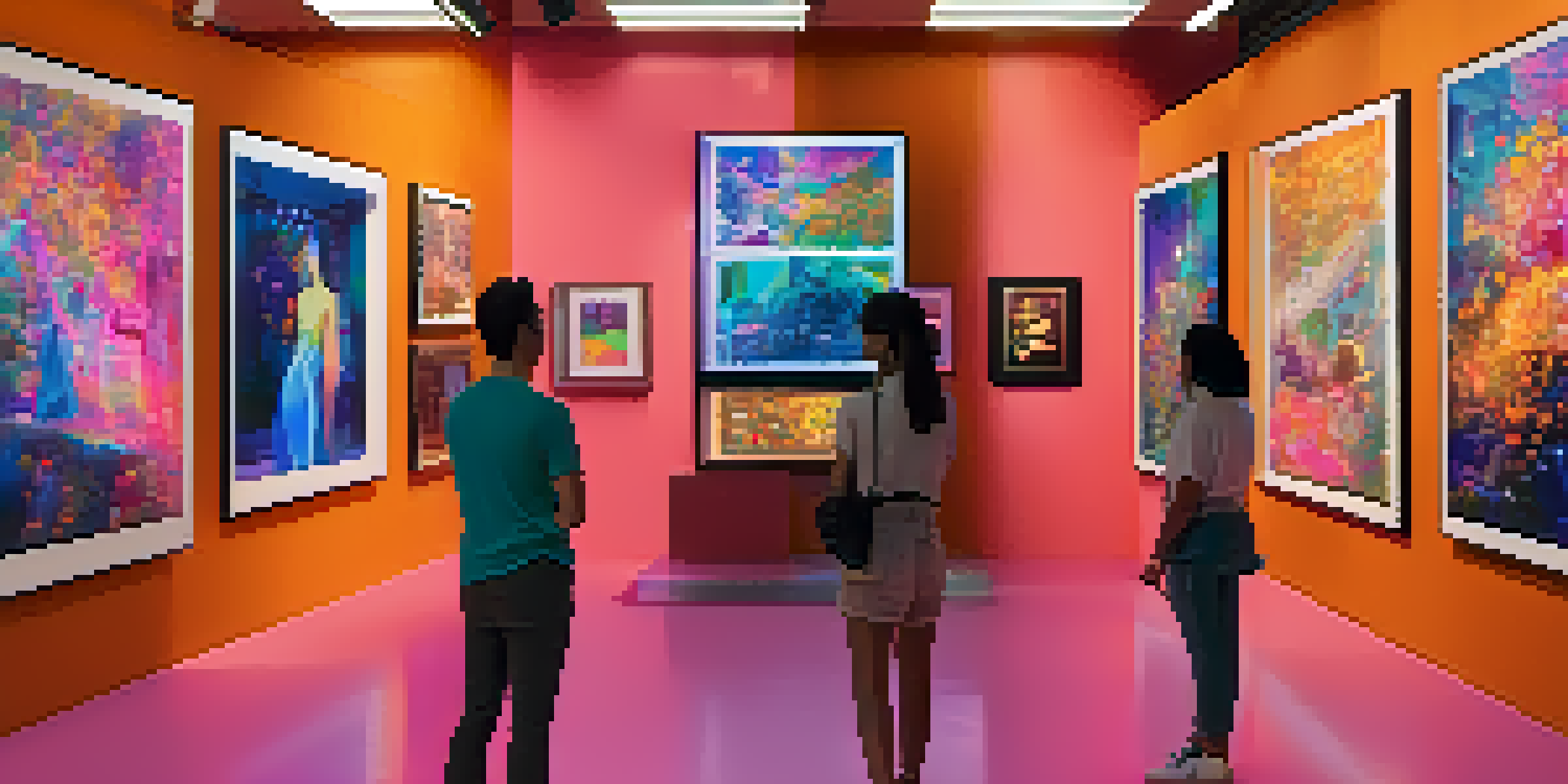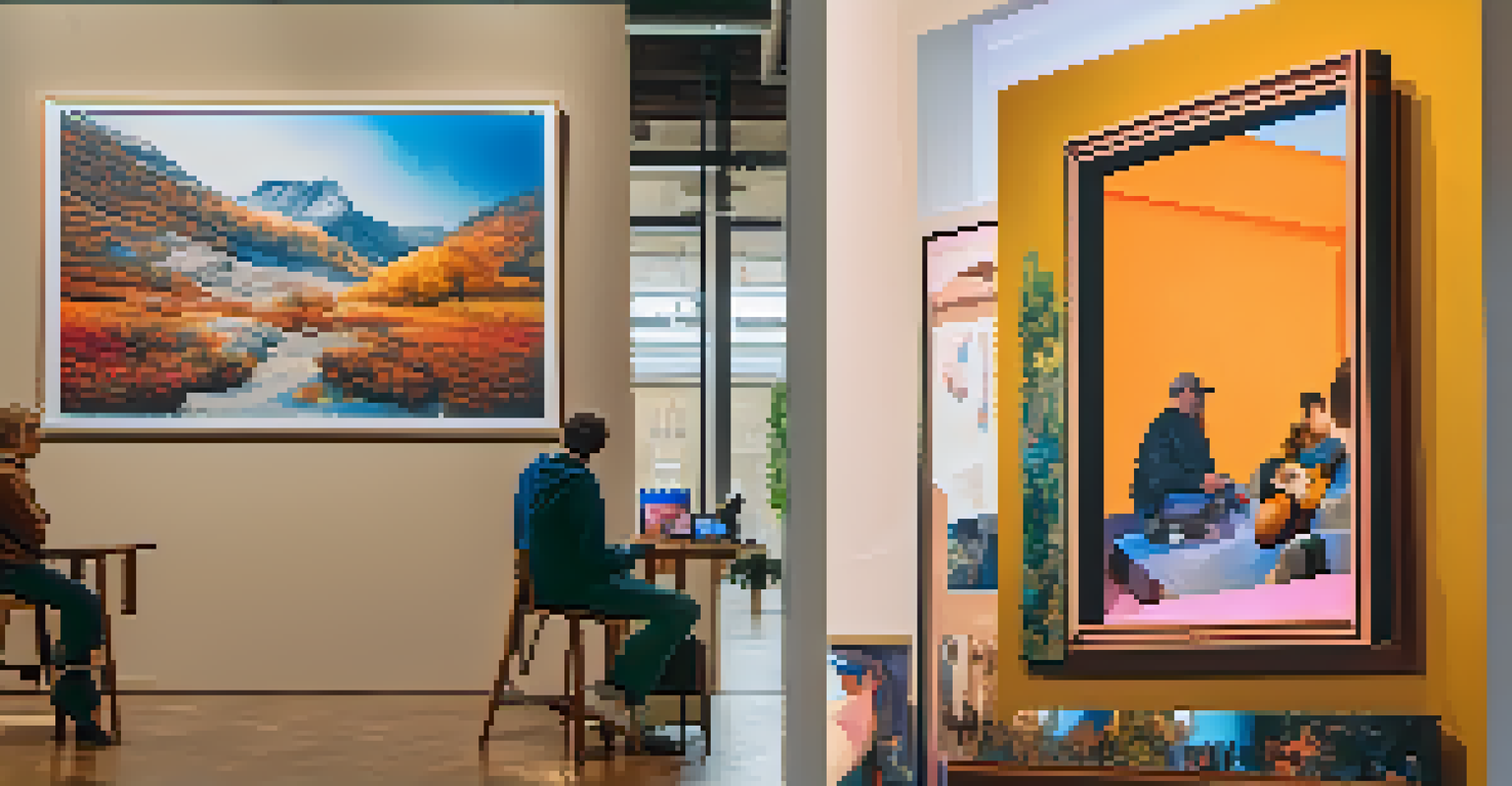NFTs vs. Traditional Photography Sales: A Comparison

Understanding NFTs: A New Digital Frontier for Art
NFTs, or Non-Fungible Tokens, represent unique digital assets verified using blockchain technology. Unlike cryptocurrencies, which are interchangeable, NFTs are one-of-a-kind pieces, making them a perfect fit for artists wanting to sell digital art. This innovation allows photographers to create a digital certificate of authenticity for their work, establishing ownership in the virtual world.
Digital art is like a puzzle with infinite pieces, and NFTs are the frame that holds it all together.
Consider a traditional photograph hanging in a gallery; its value is often tied to the artist's reputation and the physical medium itself. In contrast, an NFT allows photographers to sell their images directly to buyers without the need for physical prints or galleries, which can reduce overhead costs. This shift opens up new avenues for creative expression and monetization.
However, with the exciting new opportunities NFTs bring, there are also challenges, such as environmental concerns related to blockchain technology and market volatility. It's essential for photographers to weigh these factors while exploring NFT sales as a viable option.
The Traditional Photography Sales Model Explained
Traditional photography sales often involve physical prints, exhibitions, and galleries. Photographers must navigate the complexities of securing gallery space, printing costs, and commission fees, which can eat into their profits. This model has served artists well for decades, but it can be limiting in terms of reach and pricing flexibility.

For example, a photographer might sell a limited edition print for a set price, relying on their reputation and the allure of owning a physical piece. This can create a sense of exclusivity, leading buyers to feel like they own a piece of art history. However, the potential audience is limited to those who visit the gallery or find the prints online.
NFTs Revolutionize Art Sales
NFTs provide photographers a unique way to sell digital art directly to a global audience without traditional barriers.
The traditional model also requires ongoing promotion and networking to maintain visibility. While rewarding, it can be time-consuming and challenging for photographers to balance their creative work with the business side of selling art.
Pricing Dynamics: NFTs vs. Traditional Photography
Pricing in the NFT space can be unpredictable, influenced by market trends, collector interest, and the uniqueness of the digital asset. Photographers may set their prices based on perceived value or auction them to the highest bidder, leading to potentially significant profits or losses. This dynamic nature of pricing can be both exciting and daunting for artists.
The future of art is not about choosing between traditional and digital; it’s about finding harmony in both.
In contrast, traditional photography pricing is generally more stable, relying on established pricing strategies based on print size, rarity, and the artist's reputation. Photographers often have a clearer idea of their work's value based on historical sales data and market trends. This predictability can provide a sense of security for both artists and buyers.
However, the rigid pricing structure can limit potential earnings for photographers in a traditional setting, especially in niche markets. In this way, NFTs provide a fresh approach, encouraging photographers to think outside the box and explore new pricing strategies.
Market Reach: The Global Impact of NFTs
One of the most significant advantages of NFTs is their ability to reach a global audience without geographical limitations. Artists can sell their work directly to collectors anywhere in the world, which opens up a vast market for photographers. This democratization of art sales allows creators to tap into diverse communities and find interested buyers more easily.
In traditional photography, market reach is often confined to local galleries and exhibitions, limiting exposure and sales potential. Photographers may need to participate in art fairs or collaborate with galleries to expand their audience, which can be resource-intensive. This can pose challenges, especially for emerging artists still building their reputations.
Balancing Pricing Strategies
While NFT pricing can be unpredictable, traditional photography offers more stability, encouraging artists to explore diverse pricing models.
NFT platforms often come with built-in communities of art enthusiasts and collectors, providing photographers with instant access to potential buyers. This shift in market dynamics can significantly enhance visibility and sales opportunities for artists willing to embrace digital platforms.
Ownership and Copyright: Navigating New Norms
When selling traditional photography, ownership is straightforward: the buyer owns the physical print, but copyright often remains with the artist. This can lead to confusion about usage rights, especially if buyers wish to reproduce or share the image. Photographers must be diligent in communicating and protecting their copyright to avoid potential legal issues.
NFTs, however, can incorporate smart contracts that outline ownership rights and usage terms directly within the token itself. This means that when a buyer purchases an NFT, they not only acquire the artwork but also understand their rights regarding reproduction or resale. This clarity can significantly reduce misunderstandings and disputes.
That said, photographers must approach NFT sales with caution, ensuring they fully understand the terms of the platforms they use. The landscape of digital ownership is still evolving, and artists should stay informed about how their rights are protected in this new arena.
Environmental Concerns: Weighing the Impact
As NFTs gain popularity, concerns about their environmental impact have come to the forefront. Many blockchain networks require significant energy consumption for transactions, leading to a substantial carbon footprint. Photographers considering NFTs must be aware of these implications and seek eco-friendly platforms whenever possible.
On the flip side, traditional photography also has its environmental issues, particularly in terms of printing materials and shipping. Photographers using sustainable practices can mitigate some of these concerns, but the environmental impact remains a consideration when comparing both sales methods.
Navigating Ownership Rights
NFTs incorporate smart contracts to clarify ownership and usage rights, simplifying the complexities often found in traditional photography sales.
Ultimately, it's crucial for photographers to assess the sustainability of their chosen sales method. By prioritizing eco-friendly practices and platforms, artists can align their values with their business decisions, creating a more responsible approach to art sales.
The Future of Photography Sales: Blending Two Worlds
As the art world continues to evolve, the future of photography sales may not be about choosing one method over the other but rather finding a balance between NFTs and traditional sales. Photographers can leverage both avenues to maximize their reach and income, tapping into the strengths of each approach. This hybrid model allows artists to cater to diverse audiences while maintaining their creative integrity.
For instance, an artist might choose to sell physical prints in galleries while simultaneously offering digital versions as NFTs. This strategy can create multiple revenue streams, ensuring artists are not limited to one sales model. By diversifying their offerings, photographers can capture the interest of both traditional collectors and the growing NFT community.

Ultimately, the key to success lies in adaptability. Photographers who embrace change and explore innovative sales strategies will be better positioned to thrive in this dynamic landscape, blending the best of both worlds to create a sustainable and rewarding career.